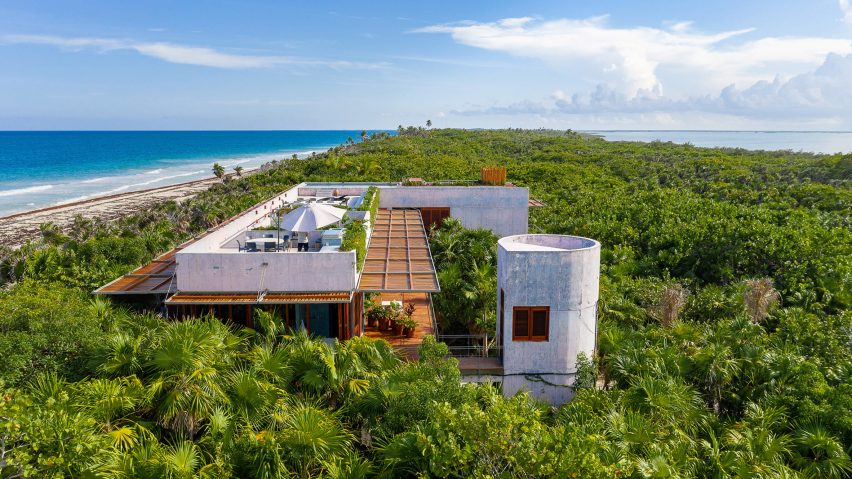A spiral staircase, rooftop pool and slatted doors feature in this concrete house in Mexico's tropical Yucatan Peninsula designed by Mexico City architecture studio Productora.
Called Casa Bautista, the two-storey home is nestled into a lush forest in Sian Ka'an biosphere reserve, which became a UNESCO World Heritage Site in 1987.
The reserve, located about an hour drive from Tulum, is divided into three zones that offer different restrictions in terms of activities. Productora designed the residence in an L-shape on a beachfront lot in the Transition Zone, where residential development for the purpose of eco-tourism is allowed.
"Sustainable development is the focus of the transition area, where local residents, economic interests, scientists, management agencies and non-government organisations work together linking conservation and economic development," Productora told Dezeen.
"In this area, a limited number of constructions can be built: these have to obey to a very strict set of regulations in terms of sustainability during construction and operation."
In keeping with the site's natural beauty, Casa Bautista is powered by solar and wind energy.
The house is elevated above the ground on cross-shaped columns as well in order to not harm the fragile ecosystem below. This design allows for expansive views over dunes revealing the aqua waters of the nearby Caribbean Sea.
Walls are made from concrete with a blue pigment the studio said "reacts over time according to its exposure to the sun and its position in the house, creating tones that range from ocean blue to sunset pink".
The home's first floor is its main level comprising an open-plan kitchen, dining and living room. Four bedrooms and three bathrooms are also located on this level, and a master suite has access to a detached, three-storey concrete turret that "doubles as a flexible space for work or meditation," Productora said.
A patio wraps around almost this entire storey and has floors covered in locally sourced wood. A wood roof above shades numerous places to sit and lounge outside – including a jacuzzi near the kitchen overlooks a white sandy beach.
A series of wood doors on hinges separate outdoor and indoor spaces, and have slats that offer shade sunlight and allow for natural ventilation.
"In this way, the interior spaces are enlarged and protected from the sun, and a good cross ventilation is achieved," said the studio, noting that only the bedrooms have air conditioning.
The patio floors and roofs also feature a folding mechanism to close off the house and protect it during a hurricane, which the region is known for.
"By raising and lowering these heavy elements against the facade, the open and transparent residence is transformed into a robust closed box," Productora added.
An outdoor spiral concrete staircase leads up to a large roof terrace with a swimming pool and an outdoor dining room.
The ground level of Casa Bautista has two bedrooms, a bathroom, mechanical room and storage spaces than can fit three kayaks and a boat.
Productora is led by Abel Perles, Carlos Bedoya, Victor Jaime and Wonne Ickx, and has offices in Mexico City and Los Angeles. In addition to this project, it has also created a pink house in Los Angeles, a concert hall takes cues from Aztec ruins and a cultural centre in Mexico's Teotitlán del Valle.
Photography is by Onnis Luque.
Project credits:
Collaborators: Alejandro Ordoñez, Josue Palma, Daniela Dusa, Antonio Espinoza, Gerardo Aguilar
Structural engineering: Kaltia
Mechnical engineering and sustainability: EOS
Interior design: Pia Hagerman
Landscape: Planta

